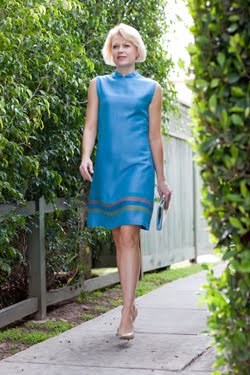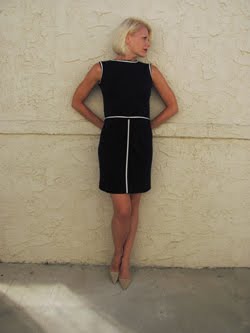As everyone knows, there is nothing so timeless in fashion as the Little Black Dress. The LBD, as many refer to it, is as close as one can get to a uniform in the fashion industry. Countless designers, editors, and models--both in front of the camera and on the street--are dressed in black on a daily basis. This goes for stylists and celebrities, too--red carpets of the award shows are always filled with black, including this year's Golden Globes (as you'll see below). And because it is so flattering and versatile, the LBD has become a staple, an essential part of the foundation of most working women's wardrobes today. As Chanel's head designer Karl Lagerfeld once said, "One is never overdressed or underdressed in a Little Black Dress." It is important to remember, though, that this was not always the case, and much of what we take for granted today is due to a film I recently covered on GlamAmor--1927's silent classic It.
As many know, Coco Chanel's October 1926 collection included her now iconic "Ford" dress (so named because, like the Model T Ford, it only came in black). Today we speak with great reverence of this being the first LBD, but it's important to realize that it did not immediately catch on at the time. In fact, Vogue only included a small sketch of the simple longsleeve black dress along with a rather understated caption:
The Chanel “Ford”--the frock that all the world will wear is model 817 of black crepe de chine. The bodice blouses slightly at the front and sides and has a tight bolero at the back. Especially chic is the arrangement of tiny tucks which cross in front. Imported by Saks.Though they do say it is a design that "all the world will wear," it hardly made that impression at first and was largely overshadowed by other more colorful couture of the day a la Patou, Paquin, and Lanvin. But Paramount's legendary costume designer Travis Banton saw it and clearly sensed a shift in the style universe. Within mere months, he chose to make a Little Black Dress the opening ensemble for Clara Bow in It. Further, it was a dress that went from day to night, transformed courtesy of a makeover that would inspire many other films such as 1986's Pretty in Pink.
All of this was completely unheard of at the time. Quite simply, before October 1926, women really only wore black to funerals. Within only a couple months, when It had its premiere in February 1927, women considered working black into their everyday wardrobes. It set us on the path for black to become the beauty basic it is today. The final push would come in the 1950s and 1960s courtesy of two other movies and Hubert de Givenchy--Sabrina (1954) and Breakfast at Tiffany's (1961). Though Chanel certainly deserves credit for drawing a historic line in the sand with the "Ford," it seems that the Little Black Dress would not have been accepted so widely and with such speed if Banton had not included it in his costumes for Clara. That is the power of film.
1927's It is beloved by silent movie fans, but remains popular with a wider audience and continues to be culturally relevant because of costume design that was influential both then and now. The film is a cornerstone of late 1920s design for any doing period pieces today, such as costume designers Mark Bridges in The Artist (2011) and Catherine Martin for Baz Luhrmann's The Great Gatsby (2013). This goes for fashion designers, too--Clara's asymmetrical bobbed hair, trademark scarves, and sweater and accordion pleated skirt are just a few of the fantastic flapper looks from the movie that are on trend today. But beyond the trends, It is an absolute landmark in fashion...significant to a degree that even the industry doesn't seem to fully appreciate. In my opinion, It played a pivotal role in launching the legacy of the Little Black Dress. Coco Chanel couldn't have asked for a bigger or better premiere.
Here is just some of the evolution of the LBD both on and off the screen--from the 1920s to the 1980s.
Here is just some of the evolution of the LBD both on and off the screen--from the 1920s to the 1980s.
ABOVE: "Little Black Dress" exhibition at SCAD Museum of Art
presented by Vogue's Andre Leon Talley
Coco Chanel in the mid-1920s
and the sketch of her groundbreaking "Ford" dress that appeared in Vogue October 1926
Model in Chanel's "Ford" dress
Clara in her LBD "makeover" stepping out for cocktails (above)
and a modern interpretation of that dress from Alaia for First Lady Michelle Obama
1930s
1930s style icon Kay Francis in off-the-shoulder black bias cut
and Emma Roberts in Lanvin at the 2014 Golden Globes
1940s
Rita Hayworth in Jean Louis for 1946's Gilda (above)
and Jessica Chastain in Givenchy channeling that very style at the 2014 Golden Globes
1950s
Elizabeth Taylor became a trendsetter for her multiple strapless dresses from Edith Head in A Place in the Sun (1951, above)
and Sofia Vergara following her lead in Zac Posen at the 2014 Golden Globes
Audrey Hepburn's Givenchy in 1954's Sabrina was an iconic LBD moment (above)
that has inspired many other LBDs--especially with boatnecks--like Ellen Page at the Critic's Choice Awards
1960s
More iconic LBD moments came again from Audrey and Givenchy in 1961's Breakfast at Tiffany's (above)
and Eva Longoria in Victoria Beckham's 2013 descendant of the dress
1970s
Julie Christie's Norman Norell in 1975's Shampoo (above) continues to be influential
because of the statement it makes coming or going, as shown by Nicole Kidman on the red carpet
1980s
Michelle Pfieffer shows that the 80s still loved 1970s style with Scarface (1983)
and Rihanna channels that look on the Grammy's red carpet in Armani
Thanks to On This Day in Fashion for the information from Vogue 1926










































































































2 comments:
Confession: I've had the movie "It" sitting on my DVR for probably three months and haven't yet seen it. Well, today I'm going to mend my ways and actually watch it.
Wonderful post! And here's to the wonderful "Little Black Dress"! *clink!*
Thanks Silver Screenings! So glad you enjoyed this and are now going to visit IT for the first time. I think you'll enjoy it and really feel the 1920s. And yes, cheers to the LBD!
Post a Comment